中考英语初中英语动词时态、语态讲义(附练习和答案)
英语中考八大时态讲解及习题

英语中考八大时态讲解及习题Ⅰ. 初中英语八种时态归纳复习1.一般现在时2.一般过去时3.现在进行时4.过去进行时5.现在完成时6.过去完成时7.一般将来时8.过去将来时一、一般现在时:概念:经常、反复发生的动作或行为及现在的某种状况。
时间状语:always, usually, often, sometimes, every week (day, year, month…), once a week, on Sundays, etc.基本结构:①be动词;②行为动词否定形式:①am/is/are+not;②此时态的谓语动词若为行为动词,则在其前加don't,如主语为第三人称单数,则用doesn't,同时还原行为动词。
一般疑问句:①把be动词放于句首;②用助动词do提问,如主语为第三人称单数,则用does,同时,还原行为动词。
二、一般过去时:概念:过去某个时间里发生的动作或状态;过去习惯性、经常性的动作、行为。
时间状语:ago, yesterday, the day before yesterday, last week(year, night, month…), in 1989, just now, at the age of 5, one day, long long ago, once upon a time, etc. 基本结构:①be动词;②行为动词否定形式:①was/were+not;②在行为动词前加didn't,同时还原行为动词。
一般疑问句:①was或were放于句首;②用助动词do的过去式did 提问,同时还原行为动词。
三、现在进行时:概念:表示现阶段或说话时正在进行的动作及行为。
时间状语:now, at this time, these days, etc.基本结构:am/is/are+doing否定形式:am/is/are+not+doing.一般疑问句:把be动词放于句首。
中考英语时态大全 练习(含答案)

知识像烛光,能照亮一个人,也能照亮无数的人。--培根
五、对主语的数判断有误 例: Li Ming with me are (be) in Beijing. 答案: is 解析:表面一看是“我和李明两个人在北京”,但 with 在此做伴随状语,不能做主语,故
用 is. 另外,宾语从句中,从句部分若是表示客观真理,不管主句是何时态,从句都要用一般现
5 / 33
知识像烛光,能照亮一个人,也能照亮无数的人。--培根
二、用动词的正确时态填空 1)I________(talk).You________(listen)tO me now. 2)Look,the boy__________(run)fast. 3)----What are you doing? ----I_________(do) my homework. 4)----_______the students_______(read) English. ----Yes,they are. 5)Tom_______(not study)English.He is studying Chinese. 6)----Who_______(sing)a song? ----Li Ying is. 7)The girl_______(not eat)bananas now. 8)----Where____they____(stand)? ----They are standing over there. 9)Look! The boy over there_______(ply) a model plane. 10)----What is Meimei doing now? ----She______(watch)TV with her parents 11)He____(study) English very hard. 12)We often____(buy)books and things like that in the shop. 13)Polly____(not eat) a banana now.
中考英语备考 专题03 动词时态及语态(含解析)
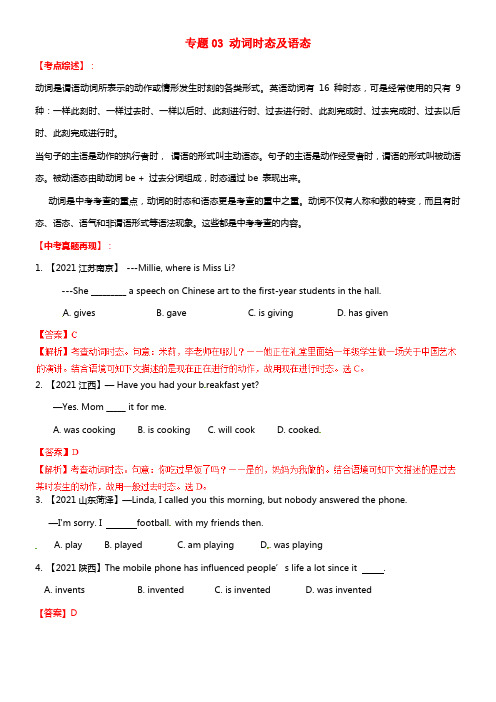
专题03 动词时态及语态【考点综述】:动词是谓语动词所表示的动作或情形发生时刻的各类形式。
英语动词有16种时态,可是经常使用的只有9种:一样此刻时、一样过去时、一样以后时、此刻进行时、过去进行时、此刻完成时、过去完成时、过去以后时、此刻完成进行时。
当句子的主语是动作的执行者时,谓语的形式叫主动语态。
句子的主语是动作经受者时,谓语的形式叫被动语态。
被动语态由助动词be + 过去分词组成,时态通过be 表现出来。
动词是中考考查的重点,动词的时态和语态更是考查的重中之重。
动词不仅有人称和数的转变,而且有时态、语态、语气和非谓语形式等语法现象。
这些都是中考考查的内容。
【中考真题再现】:1. 【2021江苏南京】---Millie, where is Miss Li?---She _________ a speech on Chinese art to the first-year students in the hall.A. givesB. gaveC. is givingD. has given2. 【2021江西】— Have you had your b reakfast yet?—Yes. Mom _____ it for me.A. was cookingB. is cookingC. will cookD. cooked3. 【2021山东菏泽】—Linda, I called you this morning, but nobody answered the phone.—I'm sorry. I football with my friends then.A. playB. playedC. am playingD. was playing4. 【2021陕西】The mobile phone has influenced people’s life a lot since it .A. inventsB. inventedC. is inventedD. was invented【答案】D【解析】考查动词时态及语态。
中考初中英语时态(动词的语态)练习题(含解析)
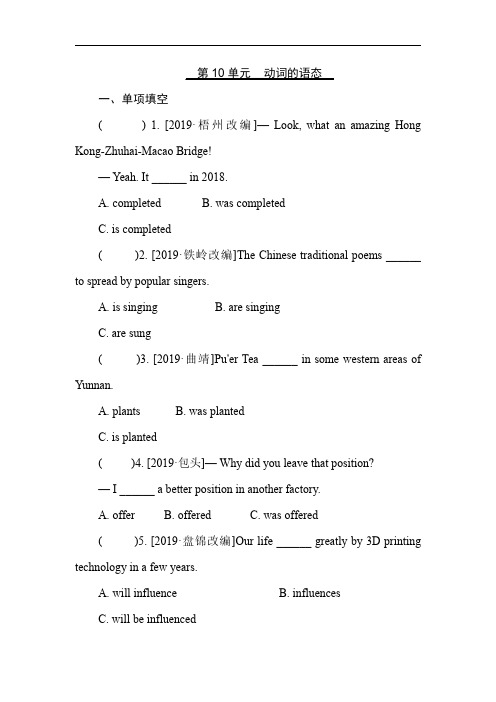
__第10单元__动词的语态__一、单项填空()1.[2019·梧州改编]—Look,what an amazing Hong KongZhuhaiMacao Bridge!—Yeah.It______in2018.pletedB.was completedC.is completed()2.[2019·铁岭改编]The Chinese traditional poems______ to spread by popular singers.A.is singingB.are singingC.are sung()3.[2019·曲靖]Pu'er Tea______in some western areas of Yunnan.A.plantsB.was plantedC.is planted()4.[2019·包头]—Why did you leave that position?—I______a better position in another factory.A.offerB.offeredC.was offered()5.[2019·盘锦改编]Our life______greatly by3D printing technology in a few years.A.will influenceB.influencesC.will be influenced()6.[2019·本溪改编]As far as I know,the robot that can sweep the floor______in the1980s.A.is inventedB.inventedC.was invented()7.[2019·贵阳]The Meitan Tea Museum,a famous building in Guizhou,______in the shape of a giant teapot.A.buildB.is buildingC.was built()8.[2019·昆明]With the rapid progress in high technology, 5G______around most parts of China in the near future.A.is usedB.is usingC.will be used()9.[2019·贵港改编]—Do you know the famous artist in red?—Sure.He______to the art festival in our city every year.A.invitesB.invitedC.is invited()10.[2019·海南]—China plans to send another spaceship into space.—Wow!More and more secrets______soon.A.are going to discoverB.will be discoveredC.have discovered()11.[2019·绥化改编]The little boy is crying because his toy______by someone a moment ago.A.was brokenB.is brokenC.broke()12.[2019·吉林改编]The environment in my hometown is improving because many trees______every year.A.plantB.plantedC.are planted()13.[2019·株洲]The students in this school______to choose their own school uniforms.A.are allowedB.allowedC.are allowing()14.[2019·南京]The China International Search and Rescue Team has brought help and hope to people in disasters around the world since it______18years ago.A.set upB.is set upC.was set up()15.[2019·眉山改编]Paper______first______about two thousand years ago by Cai Lun.A.is;inventingB.is;inventedC.was;invented()16.[2019·重庆A卷改编]His car______five years ago,but it looks quite new.A.buysB.boughtC.was bought()17.[2019·达州改编]—Dr.Bethune helped a lot of Chinese in the1930s.He is a great international soldier.—I know,so he______still______in both China and Canada now.A.has;rememberedB.is;rememberedC.will;remember()18.[2019·遂宁改编]Some people think trees______on Tree Planting Day only.A.should plantB.should be plantedC.should be plant()19.[2019·武威改编]A baby's first month birthday is a special event in China and______with a special party.A.celebratesB.is celebratedC.was celebrated()20.[2019·自贡]—Tom is always careless with his schoolwork.Could you help him?—No problem!I think he______to think twice before starting.A.should be toldB.shouldn't be toldC.should tell()21.[2019·安徽改编]The villagers expect that the building of the bridge______before the rainy season comes.A.is completedB.was completedC.will be completed()22.[2019·重庆B卷]These machines______in their factory by themselves last year.A.makeB.madeC.were made()23.[2019·连云港]It's reported the medals for the2020 Olympic Games in Tokyo______from100%recycled material.A.are makingB.have madeC.will be made()24.[2019·江西改编]Gina went to the doctor's yesterday and she______about the importance of good living habits once more.A.toldB.is toldC.was told()25.[2019·临沂]Around the world,300million tons of plastic______each year,of which about10percent ends up in the sea.A.is createdB.was createdC.creates()26.[2019·黄冈改编]—Oh,your room is too dirty,Mike!—Sorry,Mum.It______yesterday.I forgot to do it.A.didn't cleanB.isn't cleanedC.wasn't cleaned()27.[2019·南充改编]—Lucy,what have you learnt from this history class?—Paper______first______about2,000years ago in China.A.is;inventedB.was;inventedC.is;inventing()28.With the development of China,Chinese______by a large number of people in the world.A.speaksB.is spokenC.speak()29.Chinese New Year______the Spring Festival.People often eat dumplings.A.is calledB.was calledC.calls()30.In Switzerland,things like glass and plastic______ into different groups and then recycled.A.separateB.separatedC.are separated二、用括号内所给单词的适当形式填空1.[2019·绥化]It's__________(say)that the pianist will come to our city next week.2.[2019·镇江]—The plan for summer study trip may be __________(cancel).—Really?I'm looking forward to it.3.[2019·大庆]In many restaurants,tea is__________(serve)for free.4.[2019·常州]He says the problem__________(deal)with next year.5.[2018·常州]Zhu Ting,one of the best volleyball players of China, says she will return whenever she__________(need).参考答案【单元作业】一、1.B【解析】考查动词的语态和时态。
初中英语中的时态讲解+练习+答案

英语中的时态一般现在时一、功能1.表示事物或人物的特征、状态。
如:The sky is blue.天空是蓝色的。
2.表示经常性或习惯性的动作。
如:I get up at six every day.我每天六点起床。
3.表示客观现实。
如:The earth goes around the sun.地球绕着太阳转。
二、构成1. be动词:主语+be(am,is,are)+其它。
如:I am a boy.我是一个男孩。
2.行为动词:主语+行为动词(+其它)。
如:We study English.我们学习英语。
当主语为第三人称单数(he, she,it)时,要在动词后加"-s"或"-es"。
如:Mary likes Chinese.玛丽喜欢汉语。
三、在不同句式结构中的变化1. be动词的变化。
否定句:be动词后加not. 如:He is not a worker.他不是工人。
一般疑问句:be动词提前。
如:-Are you a student? -Yes. I am. / No, I'm not. 特殊疑问句:疑问词+一般疑问句。
如:Where is my bike?2.行为动词的变化。
否定句:行为动词前加do 或does.主语+ don't( doesn't ) +动词原形(+其它)。
如: I don't like bread. He doesn't often play.一般疑问句:Do( Does ) +主语+动词原形+其它。
如:- Do you often play football?- Yes, I do. / No, I don't.- Does she go to work by bike?- Yes, she does. / No, she doesn't.特殊疑问句:疑问词+一般疑问句。
如:How does your father go to work? 四、动词第三人称单数的变化规则1.一般情况下,直接加-s,如:cook-cooks, milk-milks2.以s. x. sh. ch. o结尾,加-es,如:guess-guesses, wash-washes, watch-watches, go-goes3.以“辅音字母+y”结尾,变y为i, 再加-es,如:study-studie一般现在时用法专练:一、写出下列动词第三人称单数形式并总结其规律。
中考英语专项复习专题【动词时代】(附例题以及答案)
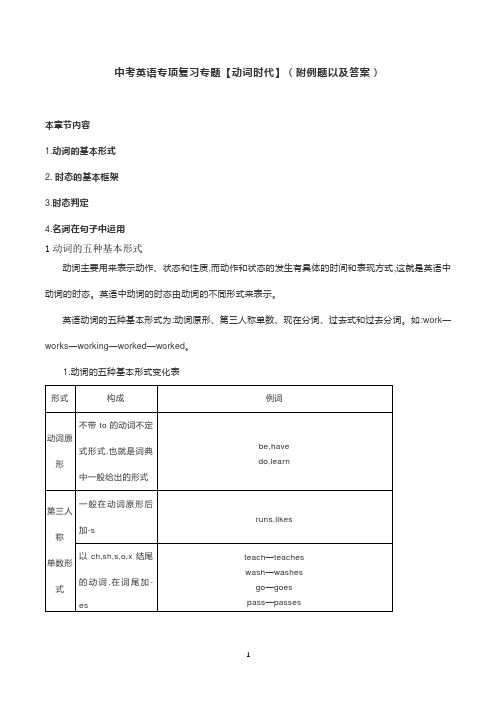
中考英语专项复习专题【动词时代】(附例题以及答案)本章节内容1.动词的基本形式2. 时态的基本框架3.时态判定4.名词在句子中运用1动词的五种基本形式动词主要用来表示动作、状态和性质,而动作和状态的发生有具体的时间和表现方式,这就是英语中动词的时态。
英语中动词的时态由动词的不同形式来表示。
英语动词的五种基本形式为:动词原形、第三人称单数、现在分词、过去式和过去分词。
如:work—works—working—worked—worked。
1.动词的五种基本形式变化表2时态的基本框架常见六种时态的构成及用法(1)一般现在时用法:①现在经常性的状态或动作;②客观事实和真理。
构成:①be+表语;②实义动词作谓语标志词:often, sometimes, usually, always, never,twice a month, every day/week/month/year(every系列)例句:He usually gets to school early.他通常很早到校。
The moon moves around the earth.月亮绕着地球转。
练一练1.认识从实践开始Knowledge practice.2.如果明天下雨,我们就不去公园了。
If it tomorrow,we to the park.【答案】1. begins with.2.rains,won’t go(2)一般过去时用法:表示过去的动作或状态。
构成:①was/were+表语;②实义动词作谓语标志词:a moment ago,just now,ago, yesterday, last night/week/month(last系列)例句:We went to Yunnan last Monday.上周一我们去了云南。
1.She (not visit)her aunt last weekend.2.My friend,Lucy, (study)for the math test and (practice)English last night. 【答案】1.didn’t visit 2.studied practiced(3)一般将来时用法:表示将来的动作或状态。
初中英语动词时态、语态讲义(附练习和答案)学习啊

学英语简单吗?肯定会有许多学生说:“难死了”。
为什么有好多学生对英语的学习都感到头疼呢?答案只有一个:“不得法。
” 英语与汉语一样都是一种语言,为什么你说汉语会如此流利?那是因为你置身于一个汉语环境中,如果你在伦敦呆上半年,保准说起英语来会非常流利。
但很多中学生没有很好的英语环境,那么你可以自己设置一个英语环境,坚持“多说”、“多听”、“多读”、“多写”,那么你的英语成绩肯定会很出色。
一、多“说”。
自己多创造机会与英语教师多讲英语,见了同学,尤其是和好朋友在一起时尽量用英语去问候,谈心情……这时候你需随身携带一个英汉互译小词典,遇到生词时查一下这些生词,也不用刻意去记,用的多了,这个单词自然而然就会记住。
千万别把学英语当成负担,始终把它当成一件有趣的事情去做。
或许你有机会碰上外国人,你应大胆地上去跟他打招呼,和他谈天气、谈风景、谈学校……只是别问及他的年纪,婚史等私人问题。
尽量用一些你学过的词汇,句子去和他谈天说地。
不久你会发现与老外聊天要比你与中国人谈英语容易的多。
因为他和你交谈时会用许多简单词汇,而且不太看重说法,你只要发音准确,准能顺利地交流下去。
只是你必须要有信心,敢于表达自己的思想。
如果没有合适的伙伴也没关系,你可以拿过一本书或其它什么东西做假想对象,对它谈你一天的所见所闻,谈你的快乐,你的悲伤等等,长此坚持下去你的口语肯定会有较大的提高。
二、多“听”寻找一切可以听英语的机会。
别人用英语交谈时,你应该大胆地去参与,多听听各种各样人的发音,男女老少,节奏快的慢的你都应该接触到,如果这样的机会少的话,你可以选择你不知内容的文章去听,这将会对你帮助很大,而你去听学过的课文的磁带,那将会对你的语言语调的学习有很大的帮助。
三、多“读”。
“读”可以分为两种。
一种是“默读”。
每天给予一定时间的练习将会对你提高阅读速度有很大的好处,读的内容可以是你的课本,但最好是一些有趣的小读物,因为现在的英语高考越来越重视阅读量和阅读速度。
人教版英语九年级全册动词时态和语态知识点及相应习题
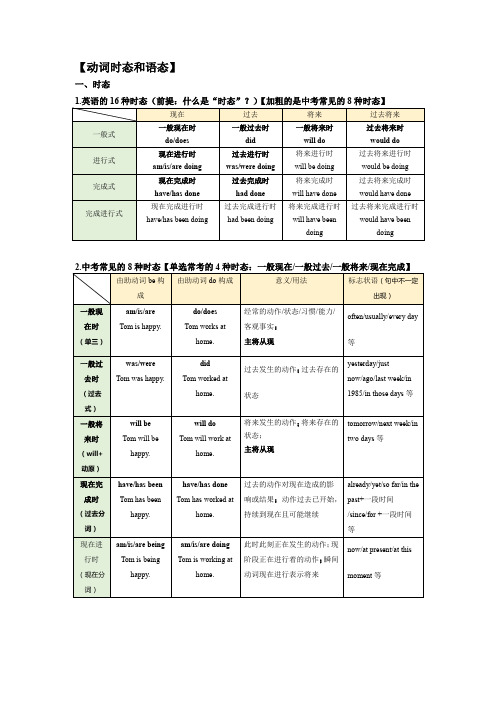
【动词时态和语态】一、时态3.主将从现(1)条件状语从句由if(如果)、as long as(只要)、unless(除非)引导,主句为一般将来时或表述将来含义,从句用一般现在时。
例如:She had better travel with a local tour guide if she wants to know more about the culture.(2)时间状语从句由when(当……时候)、as soon as(一……就……)、until(直到)等引导,主句为一般将来时或表述将来含义,从句用一般现在时。
例如:I’ll discuss this matter with you when we meet next time. / We won’t leave until Mary arrives.考点5 现在完成时have/has+(not+)过去分词(1)表示过去的动作对现在产生的结果和影响现在完成时表示过去某个时间曾经做过的、发生过的事情,对目前的某种影响,这时一般不用时间状语;也可以表示到目前为止没有发生或经历的事情。
The tickets have sold out.(票已售空。
)I have tried Italian food. It’s delicious!(我已经尝过意大利美食了。
美味啊!)Simon has seen the concert. He doesn’t want to see it again.(西蒙已经看过这场演唱会,不想再看了。
)I have never visited San Francisco in the U.S.A.(我从没去过美国的旧金山。
)(说明过去没有去过,现在仍没去过)I have just heard the news that our school will set up a press club.(我刚听到消息说我们学校要成立一个记者俱乐部。
初中英语时态讲解及练习(含答案)

初中英语时态讲解及练习(含答案)时态1. 一般现在时●形式:do does(单数第三人称)●意义:一般现在时表示客观的、普遍性的真理以及经常性的事件。
●用法:A) 表示现在发生的动作、情况、状态和特征。
B) 经常性、习惯性动作。
e.g.:He always helps others. (他总是帮助别人。
)He often goes to the gym.C) 客观事实和普遍真理。
尤其要注意,如果前后文不是一般现在时,则无法保持主句、从句时态一致。
e.g.: The sun rises in the east and sets in the west.Knowledge is power.●这一用法场合一些表动作频率的时间副词连用:1). 表示肯定的频率副词:always, frequently, usually, sometimes, generally, occasionally, often etc.2). 表示否定的频率副词:never, seldom, rarely etc.这些副词的位置:在Be动词后,实义动词前。
e.g. He is always late.2. 一般过去时●形式:did●意义:一般过去时表示在过去的某一特定时间发生和结束的活动或情况。
●用法:A) 表示过去某个时间发生的动作或情况。
e.g.: I saw him in the library yesterday morning. (有特定的时间状语)yesterday, yesterday evening, last night/month/spring/year, the night before last(前天晚上),three days/months/years ago, in 1999 etc.。
这些时间状语之前不用加介词。
B) 表示过去习惯性动作,一直持续或反复发生的动作,此时可与表示拼读的时间副词连用。
e.g.: I slept for eight hours last night. (表示在过去某一段时间内持续的动作,但这动作现在已经结束了)3. 一般将来时●形式:will/shall do或be going to do●意义:一般将来时表示在未来的某个时间将要发生的某个动作或状态。
中考初中英语语法八大时态总结(附答案)
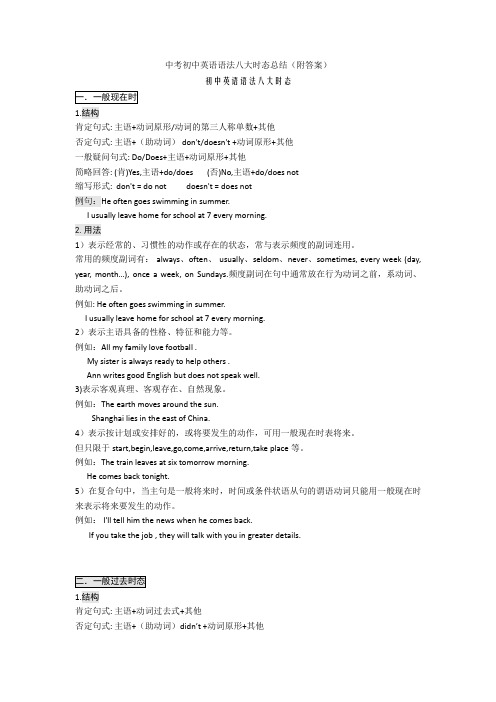
中考初中英语语法八大时态总结(附答案)初中英语语法八大时态1.结构肯定句式: 主语+动词原形/动词的第三人称单数+其他否定句式: 主语+(助动词) don't/doesn't +动词原形+其他一般疑问句式: Do/Does+主语+动词原形+其他简略回答: (肯)Yes,主语+do/does (否)No,主语+do/does not缩写形式: don't = do not doesn't = does not例句:He often goes swimming in summer.I usually leave home for school at 7 every morning.2.用法1)表示经常的、习惯性的动作或存在的状态,常与表示频度的副词连用。
常用的频度副词有: always、often、 usually、seldom、never、sometimes, every week (day, year, month…), once a week, on Sundays.频度副词在句中通常放在行为动词之前,系动词、助动词之后。
例如: He often goes swimming in summer.I usually leave home for school at 7 every morning.2)表示主语具备的性格、特征和能力等。
例如:All my family love football .My sister is always ready to help others .Ann writes good English but does not speak well.3)表示客观真理、客观存在、自然现象。
例如:The earth moves around the sun.Shanghai lies in the east of China.4)表示按计划或安排好的,或将要发生的动作,可用一般现在时表将来。
(英语)英语动词的时态常见题型及答题技巧及练习题(含答案)及解析
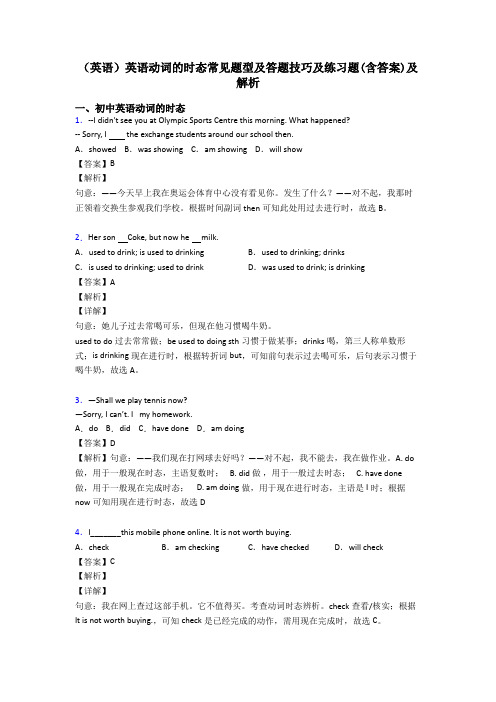
(英语)英语动词的时态常见题型及答题技巧及练习题(含答案)及解析一、初中英语动词的时态1.--I didn't see you at Olympic Sports Centre this morning. What happened?-- Sorry, I the exchange students around our school then.A.showed B.was showing C.am showing D.will show【答案】B【解析】句意:——今天早上我在奥运会体育中心没有看见你。
发生了什么?——对不起,我那时正领着交换生参观我们学校。
根据时间副词then可知此处用过去进行时,故选B。
2.Her son Coke, but now he milk.A.used to drink; is used to drinking B.used to drinking; drinksC.is used to drinking; used to drink D.was used to drink; is drinking【答案】A【解析】【详解】句意:她儿子过去常喝可乐,但现在他习惯喝牛奶。
used to do过去常常做;be used to doing sth习惯于做某事;drinks喝,第三人称单数形式;is drinking现在进行时,根据转折词but,可知前句表示过去喝可乐,后句表示习惯于喝牛奶,故选A。
3.—Shall we play tennis now?—Sorry, I can’t. I my homework.A.do B.did C.have done D.am doing【答案】D【解析】句意:——我们现在打网球去好吗?——对不起,我不能去,我在做作业。
A. do 做,用于一般现在时态,主语复数时; B. did做,用于一般过去时态; C. have done 做,用于一般现在完成时态; D. am doing做,用于现在进行时态,主语是I时;根据now可知用现在进行时态,故选D4.I_______this mobile phone online. It is not worth buying.A.check B.am checking C.have checked D.will check【答案】C【解析】【详解】句意:我在网上查过这部手机。
初中英语动词时态及语态精讲及练习(含答案)
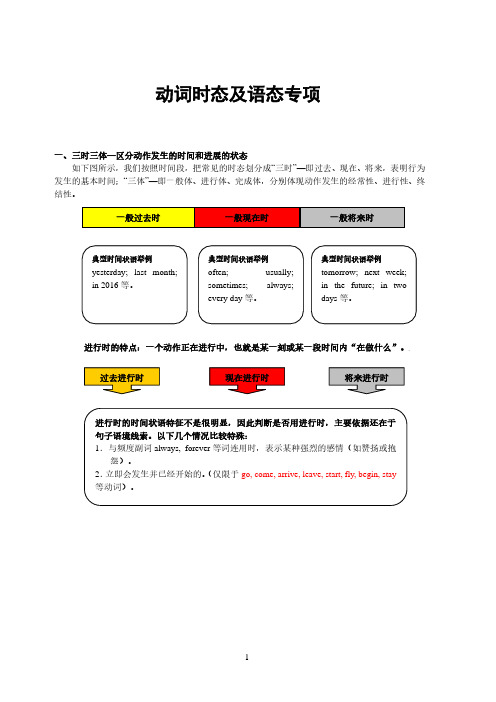
一、三时三体—区分动作发生的时间和进展的状态如下图所示,我们按照时间段,把常见的时态划分成“三时”—即过去、现在、将来,表明行为发生的基本时间;“三体”—即一般体、进行体、完成体,分别体现动作发生的经常性、进行性、终结性。
动词时态及语态专项进行时的特点:一个动作正在进行中,也就是某一刻或某一段时间内“在做什么”。
二、三种时间提示方式—判断动作发生时间和相应的时态分析历年中考时态题的题干,我们能总结出三种提示时间的方式:1. 明确时间状语。
这种情况上文已经提及,不再赘述。
2. 句子内部照应。
即主从句、并列句、并列谓语时态上相互照应。
例1:定语从句和主句的时态照应:I never saw a man who was so young but had got such fame. (主句的saw 和并列谓语had都是过去时,因此定语从句中的be 用过去时态。
)例2:宾语从句和主句的时态照应:They wrote to me saying that they would visit us the next week.(主句的wrote 决定了从句中时态只能在过去类考虑,加上时间状语the next week ,可以确定为过去将来时。
)3. 语境中的照应。
即一组意义相关的句子之间(如一个意群、一组对话)时态上相互照应。
例3:一个意群中若干句子之间的时态照应:The young girl sitting next to me on the plane was very nervous. She hadn't flown before.(前一句话用了过去时的was 。
后一句是用来解释原因的,因此用过去完成时,意为“在那之前”她没有尝试过飞行。
)例4:一组对话中若干句子之间的时态照应:—Alice, why didn’t you come yesterday?—I was going to , but I had an unexpected visitor.(问句中的didn’t come 已经告诉我们这里说的事情是过去时段。
初中英语语法:动词时态讲解及练习
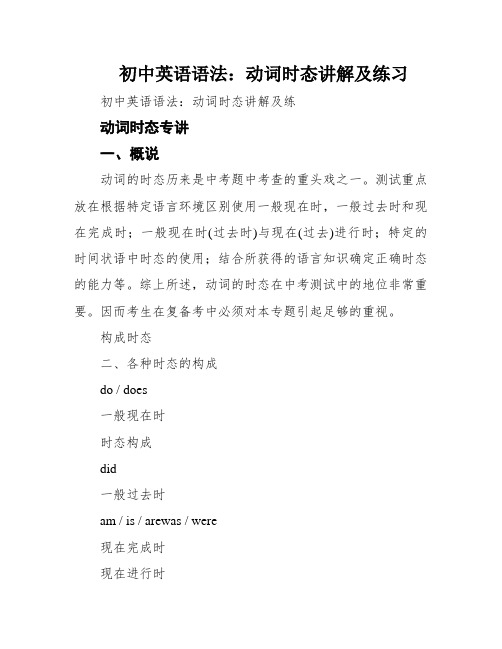
初中英语语法:动词时态讲解及练习初中英语语法:动词时态讲解及练动词时态专讲一、概说动词的时态历来是中考题中考查的重头戏之一。
测试重点放在根据特定语言环境区别使用一般现在时,一般过去时和现在完成时;一般现在时(过去时)与现在(过去)进行时;特定的时间状语中时态的使用;结合所获得的语言知识确定正确时态的能力等。
综上所述,动词的时态在中考测试中的地位非常重要。
因而考生在复备考中必须对本专题引起足够的重视。
构成时态二、各种时态的构成do / does一般现在时时态构成did一般过去时am / is / arewas / were现在完成时现在进行时一般将来时am / is / are + doinghave / has + doneshall / will + do曩昔完成时过去进行时过去将来时was / were + doingwould + dohad + donewas / were going + to doam / is / are going + to do普通目前时三、各种时态的用法1.透露表现经常性或气性的举措,常与透露表现频度的工夫状语连用。
时间状语:every day,every other day,sometimes,often,usually,on Sunday …I leave home for school at 7 _________________ (天天清晨).The Olympic Games are held ____________________ (每四年).What do you ____________ (平日) do when you are free on Sunday?2.用在客观真理,客观存在,科学事实或格言警句中。
The earth _________________ (绕着……转) the sun.Shanghai lies in the east of China.上海__________中国的东方。
【火线100天】中考英语基础【语法9】动词的时态和语态(含答案)
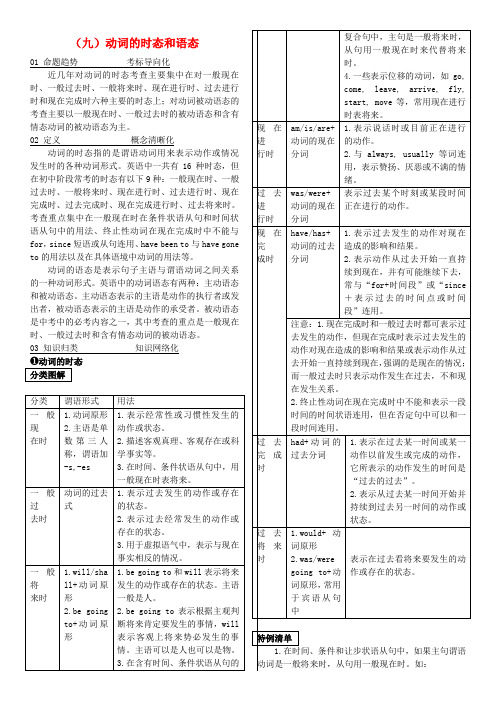
4.一些表示位移的动词,如go, come, leave, arrive, fly, start, move等,常用现在进行时表将来。
现在进
行时
am/is/are+动词的现在分词
1.表示说话时或目前正在进行的动作。
The next train leaves at 7 o’clock this evening.下一列火车将在今晚7点离开。
3.现在进行时与always, continually, forever等副词连用,表示反复出现或习惯性的动作,这种用法往往表达说话人的某种感情,如赞扬、遗憾、讨厌或不满等。如:
2.与always, usually等词连用,表示赞扬、厌恶或不满的情绪。
过去进
行时
was/were+动词的现在分词
表示过去某个时刻或某段时间正在进行的动作。
现在完
成时
have/has+动词的过去分词
1.表示过去发生的动作对现在造成的影响和结果。
2.表示动作从过去开始一直持续到现在,并有可能继续下去,常与“for+时间段”或“since+表示过去的时间点或时间段”连用。
(九)动词的时态和语态
01命题趋势考标导向化
近几年对动词的时态考查主要集中在对一般现在时、一般过去时、一般将来时、现在进行时、过去进行时和现在完成时六种主要的时态上;对动词被动语态的考查主要以一般现在时、一般过去时的被动语态和含有情态动词的被动语态为主。
02定义概念清晰化
动词的时态指的是谓语动词用来表示动作或情况发生时的各种动词形式。英语中一共有16种时态,但在初中阶段常考的时态有以下9种:一般现在时、一般过去时、一般将来时、现在进行时、过去进行时、现在完成时、过去完成时、现在完成进行时、过去将来时。考查重点集中在一般现在时在条件状语从句和时间状语从句中的用法、终止性动词在现在完成时中不能与for,since短语或从句连用、have been to与have gone to的用法以及在具体语境中动词的用法等。
(英语)中考英语动词的时态练习题及答案含解析
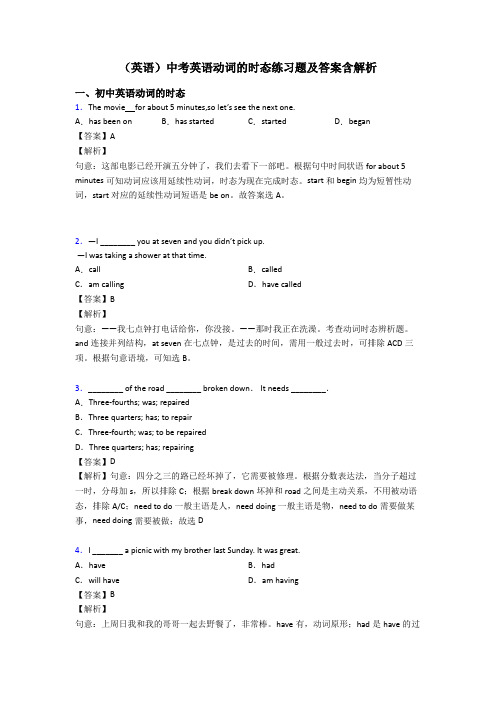
— Sorry. I have no idea. But he was here just now.
A.where Tom wasB.where Tom has gone
C.where can I find TomD.where Tom has been
2.—I ________ you at seven and you didn’t pick up.
—I was taking a shower at that time.
A.callB.called
C.am callingD.have called
【答案】B
【解析】
句意:——我七点钟打电话给你,你没接。——那时我正在洗澡。考查动词时态辨析题。and连接并列结构,at seven在七点钟,是过去的时间,需用一般过去时,可排除ACD三项。根据句意语境,可知选B。
A.had B.will have C.were having D.are having
【答案】D
【解析】句意:如今的年轻人没有智能手机就无法生存。当他们吃饭的时候,他们随时都会拿起手机。考查动词时态辨析题。while当……的时候,表示从句动作和主句动作同时发生,常用进行时态。根据句意语境,可知选D。
7.—Why are you walking so quickly, Edward?
—There_____ a talent show in ten minutes.
A.will haveB.will be
C.is going to haveD.are going to be
【答案】B
【解析】
初三英语时态语态精讲多练附练习答案

时态语态动词时态包括:1、一般现在时2、一般过去时3、现在进行时4、现在将来时5、过去进行时6、现在完成时7、过去将来时8、过去完成时一、一般现在时句型:1、主语(复数名词、代词:I、you ,they)+ 动词原形2、主语(单数名词、代词:he,she,it)+ 动词(加s、es)3、否定句、疑问句中的一般现在时一般现在时与时间状语1、一般现在时表示经常性或习惯性动作。
常用的时间状语有:always, usually, often, never, sometimes, every(….), once a week, on Saturday2、在时间,条件状语从句中If it doesn’t rain tomorrow, we’ll go for a picnic.I will tell her the message as soon as I see her.She wouldn’t stop crying until her mother came home. 3、一般现在时表客观事实或普遍真理The teacher said that the moon is smaller than the earth.二、一般过去时句型:1、主语+did/ 主语+ was、were2、助动词有:did/was/were;既行为动词没有主谓一致变化;be动词单数是was 复数是were3、熟记动词的过去时态形式过去时及其用法1、一般过去时表过去某时发生的动作或存在的状态2、常见时间状语有:yesterday, last…,… ago,just now , in+过去时间, one day, at the age of,when例如:The boy began to learn English when he was five. Jack often got up very late during the summer holiday.Did you visit the Great Wall while you were traveling in BJ?三、现在进行时句型:1、主语+(is, am, are)+现在分词(v-ing)2、现阶段“正在,在” 进行的动作,常用时间状语有:now, rightnow, at the moment, these days, look!例如:1.Have you moved into your new house?---Not yet. It ____ (paint)2.Look there! Ma Ning ______(play) basketball alone.四、现在将来时句型:1、主语+will do…or will be…主语+ (is am are) going…2、有些动词象:go, come, arrive, leave,start, die 等表示移动的动词,它们的进行时态形式表示将来The Greens are leaving for Shanghai tomorrow.3、一般将来时表示“将,将要”来要发生的动作或状态,常用时间状语有:tomorrow, this afternoon , next week, in+一段时间五、过去进行时句型:1、was/were + doing…2、过去某个“时间点” “正在,在” 进行的动作3、时间状语有:at seven yesterday morning, from 9 to 10 last night, at this time last Monday, when、while等例如:I was watching TV when my teacher came to my home.He was drinking with us when the killing happened.It was 8:00 now, and he was having his breakfast.六、现在完成时1.现在完成时:顾名思义,现在完成时表示的是已经完成的动作,但动作造成的影响还在,常被just,already,yet 等副词修饰。
- 1、下载文档前请自行甄别文档内容的完整性,平台不提供额外的编辑、内容补充、找答案等附加服务。
- 2、"仅部分预览"的文档,不可在线预览部分如存在完整性等问题,可反馈申请退款(可完整预览的文档不适用该条件!)。
- 3、如文档侵犯您的权益,请联系客服反馈,我们会尽快为您处理(人工客服工作时间:9:00-18:30)。
初中英语动词时态语态讲义(附练习和答案)11. 动词的时态11.1 一般现在时的用法1)经常性或习惯性的动作,常与表示频腮度的时间状语连用。
时间状语:every…, sometimes, at…, on Sunday。
例如:I leave home for school at 7 every morning. 每天早上我七点离开家。
2)客观真理,客观存在,科学事实。
例如:The earth moves around the sun. 地球绕太阳转动。
Shanghai lies in the east of China. 上海位于中国东部。
3)表示格言或警句。
例如:Pride goes before a fall. 骄者必败。
注意:此用法如果出现在宾语从句中,即使主句是过去时,从句谓语也要用一般现在时。
例:Columbus proved that the earth is round. 哥伦布证实了地球是圆的。
4)现在时刻的状态、能力、性格、个性。
例如:I don't want so much. 我不要那么多。
Ann writes good English but does not speak well. 安英语写得不错,讲的可不行。
比较:Now I put the sugar in the cup. 把糖放入杯子。
I am doing my homework now. 我正在做功课。
第一句用一般现在时,用于操作演示或指导说明的示范性动作,表示言行的瞬间动作。
第二句中的now是进行时的标志,表示正在进行的动作的客观状况,所以后句用一般现在时。
11.2 一般过去时的用法1)在确定的过去时间里所发生的动作或存在的状态。
例如:时间状语有:yesterday, last week, an hour ago, the other day, in 1982等。
例如:Where did you go just now? 刚才你上哪儿去了?2)表示在过去一段时间内,经常性或习惯性的动作。
例如:When I was a child, I often played football in the street. 我是个孩子的时候,常在马路上踢足球。
Whenever the Browns went during their visit, they were given a warm welcome.那时,布朗一家无论什么时候去,都受到热烈欢迎。
3)句型:It is time for sb. to do sth "到……时间了" "该……了"。
例如:It is time for you to go to bed. 你该睡觉了。
It is time that sb. did sth. "时间已迟了" "早该……了" ,例如It is time you went to bed. 你早该睡觉了。
would (had) rather sb. did sth. 表示'宁愿某人做某事'。
例如:I'd rather you came tomorrow.还是明天来吧。
4) wish, wonder, think, hope 等用过去时,作试探性的询问、请求、建议等,而一般过去时表示的动作或状态都已成为过去,现已不复存在。
例如:I thought you might have some. 我以为你想要一些。
比较:Christine was an invalid all her life.(含义:她已不在人间。
) Christine has been an invalid all her life.(含义:她现在还活着)Mrs. Darby lived in Kentucky for seven years. (含义:达比太太已不再住在肯塔基州。
)Mrs. Darby has lived in Kentucky for seven years. (含义:现在还住在肯塔基州,有可能指刚离去)注意:用过去时表示现在,表示委婉语气。
1)动词want, hope, wonder, think, intend 等。
例如:Did you want anything else? 您还要些什么吗?I wondered if you could help me. 能不能帮我一下。
2)情态动词 could, would。
例如:Could you lend me your bike? 你的自行车,能借用一些吗?11.3 used to / be used toused to + do:"过去常常"表示过去习惯性的动作或状态,但如今已不存在。
例如:Mother used not to be so forgetful. 老妈过去没那么健忘。
Scarf used to take a walk. 斯卡夫过去常常散步。
be used to + doing:对……已感到习惯,或"习惯于",to是介词,后需加名词或动名词。
例如:He is used to a vegetarian diet.Scarf is used to taking a walk. 斯卡夫现在已习惯于散步了。
典型例题---- Your phone number again? I ___ quite catch it.---- It's 69568442.A. didn'tB. couldn'tC. don'tD. can't答案A. 本句虽没有明确的时间状语,但从语意上看出,在听的时候没有听懂这个动作发生在过去,因此应用过去时。
11.4 一般将来时1)shall用于第一人称,常被will 所代替。
will 在陈述句中用于各人称,在征求意见时常用于第二人称。
例如:Which paragraph shall I read first?我先读哪一段呢?Will you be at home at seven this evening? 今晚七点回家好吗?2)be going to +不定式,表示将来。
a. 主语的意图,即将做某事。
例如:What are you going to do tomorrow? 明天打算作什么呢?b. 计划,安排要发生的事。
例如:The play is going to be produced next month。
这出戏下月开播。
c. 有迹象要发生的事。
例如:Look at the dark clouds, there is going to be a storm. 看那乌云,快要下雨了。
3)be +不定式表将来,按计划或正式安排将发生的事。
例如: We are to discuss the report next Saturday.我们下星期六讨论这份报告。
4) be about to +不定式,意为马上做某事。
例如:He is about to leave for Beijing. 他马上要去北京。
注意:be about to do 不能与tomorrow, next week 等表示明确将来时的时间状语连用。
11.5 be going to / will 用于条件句时,be going to表将来,will表意愿。
例如:If you are going to make a journey, you'd better get ready for it as soon as possible.Now if you will take off your clothes, we will fit the new clothes on you in front of the mirror.11.6 be to和be going tobe to 表示客观安排或受人指示而做某事,be going to 表示主观的打算或计划。
例如:I am to play football tomorrow afternoon. 明天下午我去踢球。
(客观安排)I'm going to play football tomorrow afternoon. 明天下午我想去踢球。
(主观安排)11.7 一般现在时表将来1)下列动词come, go, arrive, leave, start, begin, return的一般现在时可以表示将来,主要用来表示在时间上已确定或安排好的事情。
例如:The train leaves at six tomorrow morning. 火车明天上午六点开。
When does the bus star? It stars in ten minutes. 汽车什么时候开?十分钟后。
2)以here, there等开始的倒装句,表示动作正在进行。
例如: Here comes the bus. = The bus is coming. 车来了。
There goes the bell. = The bell is ringing. 铃响了。
3)在时间或条件句中。
例如:When Bill comes (不是will come), ask him to wait for me. 比尔来后,让他等我。
I'll write to you as soon as I arrive there. 我到了那里,就写信给你。
4)在动词hope, take care that, make sure that等的宾语从句中。
例如:I hope they have a nice time next week. 我希望他们下星期玩得开心。
Make sure that the windows are closed before you leave the room. 离开房间前,务必把窗户关了。
11.8 用现在进行时表示将来下列动词come, go, arrive, leave, start, begin, return等现在进行时可以表示将来。
例如:I'm leaving tomorrow. 明天我要走了。
Are you staying here till next week? 你会在这儿呆到下周吗?11.9 现在完成时现在完成时用来表示之前已发生或完成的动作或状态,其结果的影响现在还存在;也可表示持续到现在的动作或状态。
其构成:have (has) +过去分词。
11.10 比较一般过去时与现在完成时1)一般过去时表示过去某时发生的动作或单纯叙述过去的事情,强调动作;现在完成时为过去发生的,强调过去的事情对现在的影响,强调的是影响。
